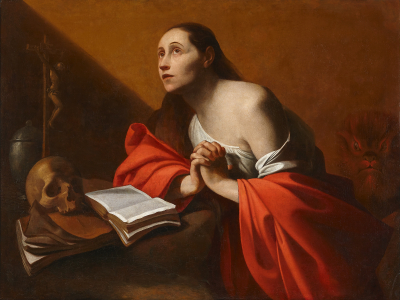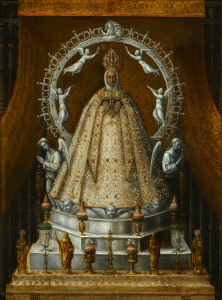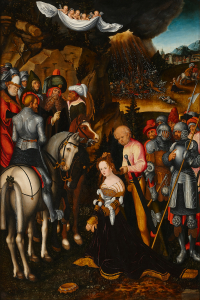Ulrich Loth (before 1599-1662)
Ulrich Loth (before 1599-1662)
This recently rediscovered painting of the Penitent Magdalene is an important addition to the oeuvre of the German artist Ulrich Loth. Works by Loth are rare, and are only available for purchase very sporadically. His documented oeuvre comprises 92 paintings, of which 48 are considered lost or whereabouts unknown. This painting from the latter category can now be reincluded in Ulrich Loth’s remarkably small body of works.
Mary Magdalene is portrayed wearing red and white vestments, kneeling before a rock with her hands clasped in prayer and her gaze turned upwards. In front of her are an open book and a skull; behind these we see a bundle of twigs meant for use as a scourge, a cross, and a jar of ointment. On the right, behind Mary Magdalene, is the face of a demon.
Mary Magdalene was a popular subject in sixteenth- and seventeenth-century art, and one that was widely endorsed, especially by the Catholic Church. Although she was a sinful woman, she eventually became one of Christ’s apostles and was canonised as a saint by the Church, thus forming the ultimate example of the principle that it is never too late to repent for one’s sins. Through penance and remorse, Mary Magdalene was able to walk the path of righteousness after giving up her riches. As such, the Church used her portrayal and her story to demonstrate that penance paid off, and to persuade the faithful to donate their wealth to the Church.
Of particular note from an iconographic perspective are the depiction of the demon next to Mary Magdalene, along with the ointment jar and the book. Based on the Bible, these attributes referred to separate figures, who were merged into one in the early days of the Catholic Church. In this traditional Western Catholic view, three women from the New Testament are jointly identified as one: Mary Magdalene; Mary the sister of Martha and Lazarus, who was allegedly also referred to as Magdalene but is now known as Mary of Bethany; and the anonymous sinful woman from Luke 7, who anointed Christ’s feet with precious oil. The latter is why Mary Magdalene is now assumed to have been a prostitute, since the sinful woman of ill repute in Luke 7 is described as “a woman of the city”. The portrayal of Mary Magdalene with her hair undone – a taboo at the time – can also be interpreted in this light.
Although the painting is unsigned, it can be attributed with certainty to the southern German painter Ulrich Loth (before 1599-1662), one of Munich’s leading artists in the seventeenth century. He was a student of Peter Candid (Peter de Witte 1548-1628), and later became court painter to Maximilian of Bavaria.
His four-year stay in Italy to complete his apprenticeship, from 1619 to 1623, was a particularly important period in his life, as it resulted in his return to his fatherland as the first German follower of Caravaggio. Although today he has fallen into relative obscurity, he had a pronounced influence on the course of German Mannerism at the time. Loth was an active painter who received many commissions from churches after he relinquished his position as a court painter in 1629, as well as from the free market and the court, which had not forgotten him. His later works came to be influenced by Rubens, which shows that he continued to follow the European fashion.
In The Penitent Mary Magdalene, Caravaggio’s influence is clearly visible: in the sharply contrasting lighting in the background, the pronounced forward stoop in Magdalene’s posture, and her naked shoulder in foreshortened perspective.
Ulrich Loth painted a nearly identical composition in 1630. That painting – which now graces the Bavarian State Painting Collections – was commissioned by a noble Bavarian couple, as evidenced by their family crest painted in the upper right corner of the canvas. Whether the painting shown here was created before or after the aforementioned piece is unknown. What we do know is that Loth frequently chose the penitent Magdalene as a subject – as, incidentally, did Caravaggio.
Schloss Schleißheim must have been bedecked with works made by Ulrich Loth during his time as a court painter, but many of his works disappeared from the palace before 1760. Inventories from 1748 and 1765 show that at least two works by Loth depicting the penitent Magdalene were present in the castle in those years.
Although the dimensions do not match, it is likely that the painting shown here corresponds with the painting described under inventory number A 748/1 in 1748 and number A 751/1 in 1765: the dimensions given there (134 x 103 cm) differ by 11 to 12 cm in width and height, which would allow for a frame between 5.5 and 6 cm. In contrast to current practice, it was not uncommon in those days to include the frame in a painting’s dimensions. Loth’s catalogue raisonné names Die Büssende Magdalena from Schloss Schleiβheim in a list of works whose whereabouts are unknown, noting that it was present in the castle before 1748 and was last seen there in 1751, allowing us to finally re-identify this painting today, more than 250 years later.
Literature:
Ulrich Loth; Zwischen Caravaggio und Rubens, Exh. cat. Alte Pinakothek München 2008, p.118,119, p.287
- Provenance
- Schleiβheim Castle before 1748-1751 (see literature: Verlorene oder verschollene Gemälde p. 287)
Private collection, Germany - Period
- ca. 1630
- Material
- oil on canvas
- Dimensions
- 92 x 122 cm
Global shipping available









